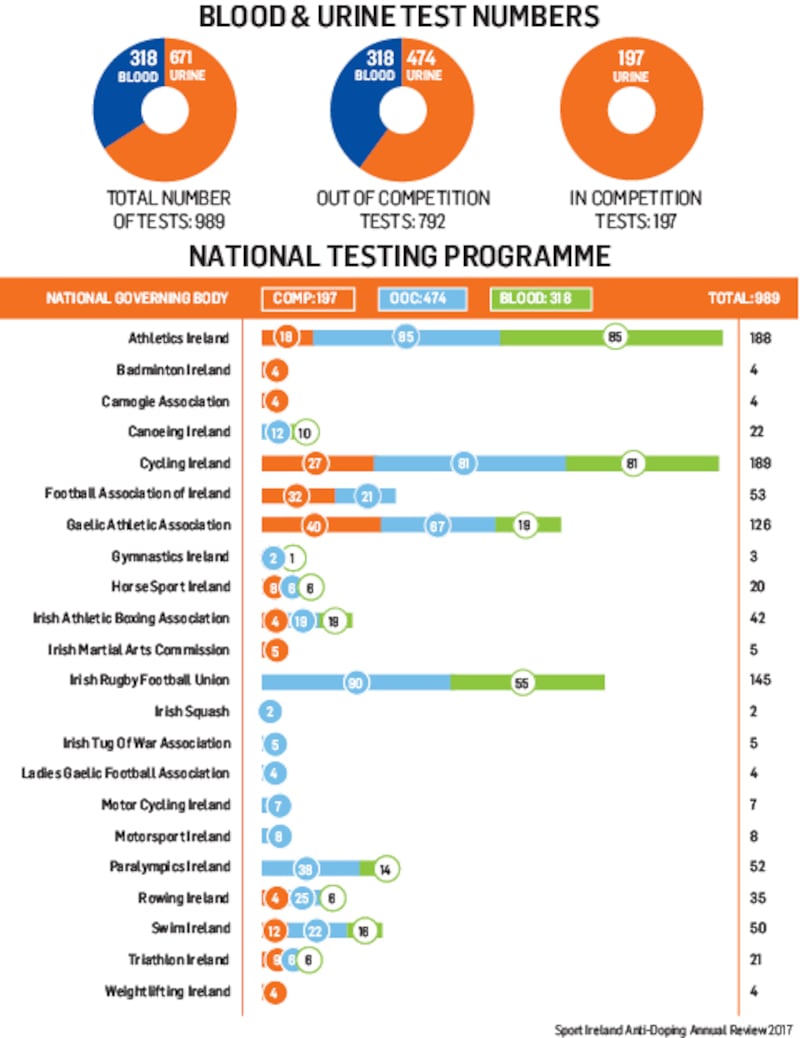Anti-doping in sport has always been a sort of stand-off between the statistics and the truth, and the latest report from Sport Ireland is no exception. One positive out of almost 1,000 tests – or 0.1 per cent – is certainly open to interpretation.
Depending on what you believe, it means Ireland is pretty squeaky clean when it comes to doping, or else the testing is not quite doing its job. Indeed, this time last year Sport Ireland published a survey which claimed 42 per cent of 148 elite Irish athletes, across 14 sports, personally knew others who used banned substances. Six per cent admitted they themselves had knowingly used one.
According to their 2017 Anti-Doping annual report, now in its 18th year, of the 989 tests carried out by Sport Ireland, across 22 sports, only one came back positive, from an in-competition test. That case, for a banned substance, is still pending, the identity of the sport or individual yet to be revealed. Going by recent test cases, it could drag on.

There were a further 315 user-pay tests, carried out on behalf of 10 international organisations, but it’s one of the lowest returns in that 18-year anti-doping history. In 2016 there were five positive cases, including Olympic boxer Michael O’Reilly and Kerry footballer Brendan O’Sullivan.
Even with all the necessary sampling boxes neatly ticked – in-competition, out-of-competition, blood, urine, etc – it also raises a question over whether the now hefty €1.75 million annual taxpayer cost represents any sort of return on the investment.
Closed the gap
What is certain is that rugby has closed the gap on cycling and athletics as the third-most-tested sport in Ireland. Of those 989 tests, 189 were in cycling, 188 in athletics, and 145 in rugby. Of the 1,003 tests in 2016, 250 were in athletics, 155 in cycling, and 113 in rugby. It means rugby testing is up almost 30 per cent on the previous year.
“We’re always shifting the emphasis a little from one sport to the next,” said Dr Una May, long-serving head of Sport Ireland’s anti-doping committee. “And in a post-Olympic year, we find we lose a lot of high-level individual athletes on the registered testing pool, and that gives us the opportunity to maybe boost testing in other sports.
“But our testing in rugby is almost all targeted in some way, as is all our testing. We don’t generally go to an out-of-competition testing without having a list of names we want tested.”
GAA (126 tests) and soccer (53 tests) are further down the list, and while the three main team sports can be subjected to the same basic testing procedures, GAA players still aren’t tested at home.
Commenting on the single positive test, and that €1.75 million cost, Sport Ireland chief executive John Treacy said it wasn’t all about catching the cheats.
“Any system of anti-doping is as much about the deterrent,” said Treacy, “and while you mightn’t always have positive cases, you might be stopping people from going down that road.
Rigorously
“And I can’t guarantee we mightn’t have three or four next year. We do our job as rigorously as we possibly can, and any information at all we follow up on, and target-test, simple as that. I think most athletes in Ireland will tell you they are tested, and if you are in a high-risk sport, you’ll be tested more.”
Sport Ireland also approved 27 Therapeutic Use Exemptions (TUEs) in 2017 – from 81 applications – some of the problems with which have been highlighted by the UK parliament’s report into Team Sky. Most of those applications were for TUEs which are no longer on the banned list. Rugby and athletics both had six TUEs, cycling only two, but Dr May was confident these were largely legit: “It’s actually one less than last year, with five rejected [for being incomplete], but I think we have a very rigorous system, and if our TUE committee are not comfortable with something, they will fight backwards and forwards.
“With rugby, without being specific, we get the normal things like asthma, we get the injury treatments as well, but it’s not excessive. And one of the things we’d always have a concern with was around the grey area, being treated maybe unethically, from a medical point of view. But when we’re only getting six, in rugby, I don’t think that’s an issue.”













